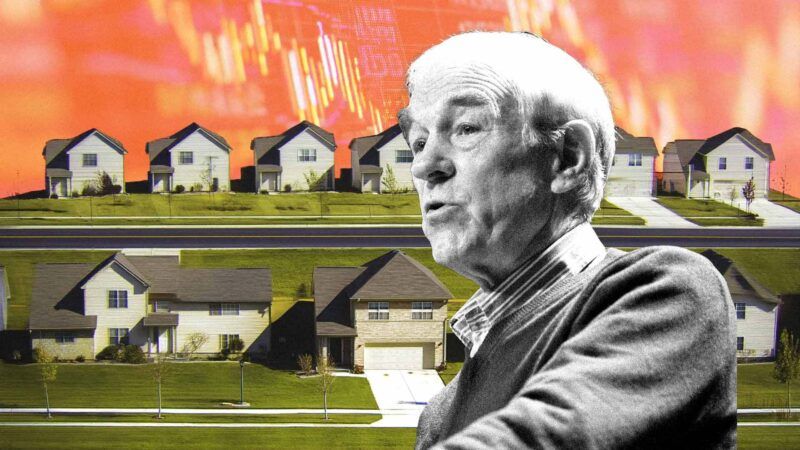Trump Doesn't Need the Fed To Fix Housing
Former Rep. Ron Paul argues that slashing red tape will do more to bring down home prices than pressuring the central bank to cut interest rates.

President Donald Trump, eager for some good economic news to offset headlines about his tariff fallout, is joining the long list of presidents and other politicians pressuring the Federal Reserve to cut interest rates.
The president recently posted on Truth Social that Federal Reserve Chairman Jerome Powell is "always TOO LATE AND WRONG" and that his "termination cannot come fast enough."
Exposing the dangers of the Federal Reserve was my main motivation for getting into politics. However, I do not agree that a president should fire a Federal Reserve chair because they refuse to follow orders to cut rates faster.
Interest rates are the price of money—and government price-setting never works, whether it's done by central bankers or politicians. Artificially low interest rates are what caused the Great Depression, the housing bubble, the post-COVID surge in consumer prices, and every downturn that has occurred since Congress made the mistake of creating a central bank in 1913.
Forcing interest rates lower than their true market rate leads builders to start massive construction projects, companies to expand recklessly, and consumers to take on mortgages and debt they can't really afford. In the short term, it looks like a boom—jobs grow, markets rise, and politicians pat themselves on the back. But it's a house built on sand.
Eventually, reality sets in. The malinvestments—investments that made sense only under distorted interest rates—are exposed. Housing developments sit empty. Borrowers default. Banks tighten credit. And then the crash comes.
To fix the housing industry, Trump doesn't need to increase economic intervention—he just needs to unleash the housing market. Fortunately, he has already gotten started.
His day one executive order on "Delivering Emergency Price Relief for American Families and Defeating the Cost-of-Living Crisis" aims to slash through the tangled web of state and local regulations that choke off new housing supply. Housing and Urban Development Secretary Scott Turner and Interior Secretary Doug Burgum also announced a joint task force to build new homes on federal land.
Trump also seems to believe in letting housing markets operate efficiently so supply can rise to meet demand. His administration can help make that happen by ending the previous administration's Department of Justice (DOJ) antitrust lawsuit against the software firm RealPage, which it alleged helped landlords artificially raise rents.
In reality, this software helps property owners better understand their market rate valuations (much like Kelley Blue Book does for car owners and buyers). Yet, time and time again on the campaign trail, former President Joe Biden and former Vice President Kamala Harris falsely claimed this pricing software was driving up costs for renters—an attempt to shift blame for high prices away from the government and the Fed.
Blaming pricing software for rising rents is like blaming the thermometer for a fever. It's not landlords' and homeowners' fault that inflation under Biden's watch forced them to raise their prices.
Once Trump succeeds in achieving zoning and permitting reform, this innovative new pricing technology will help reduce home prices faster. Why? Because deregulation lowers prices, and this software provides real-time market pricing. That's why fending off this Biden-era regulatory overreach is so important. Innovation helps drive prices down.
Deregulation is almost always the answer. Interventionism is not. We must stop depending on central bankers to "fix" the economy with levers and dials. Every manipulated boom leads to a bust. Every time Washington intervenes, it creates distortions that punish savers, reward speculation, and ultimately hurt the very people it claims to want to help.
The real solution isn't more planning—it's more freedom. Let markets set interest rates. Let prices rise and fall. Let supply and demand work without interference. That's not just sound policy—it's sound money.
